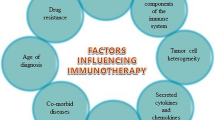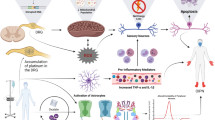Summary
Many cancer patients are cured from their malignant tumor, but may suffer from long-term, chemotherapy-induced peripheral neuropathy. This frequent and often disabling condition results from treatment with anticancer drugs including microtubulin-targeting agents such as taxanes, vinca alkaloids, and some immunotoxins; platinum compounds; certain proteasome inhibitors like bortezomib; and immunomodulatory drugs such as thalidomide. Moreover, immune checkpoint inhibitors can cause an autoimmune-mediated peripheral neuropathy. Neuropathic symptoms include pain, numbness, tingling, or cold hypersensitivity in the hands and feet, as well as motor weakening or disorders of the autonomous nerve system. Medical treatment is often unsatisfactory. First-line options include antidepressants like duloxetine, venlafaxine or amitriptyline, and antineuropathic drugs like gabapentin or pregabalin. In addition, topical therapies with capsaicin or lidocaine have been applied. In severe cases, medication with tramadol or opioids may be required for painful paresthesia. Physiotherapy, sensory integrative occupational therapy, and various physical agents can be helpful. The course of disease, however, is usually protracted, and the symptoms generally gradually decrease. In this short overview, we describe medical and physical treatment options for chemotherapy-induced peripheral neuropathy.
Similar content being viewed by others
References
Wolf SL, Barton DL, Qin R, et al. The relationship between numbness, tingling, and shooting/burning pain in patients with chemotherapy-induced peripheral neuropathy (CIPN) as measured by the EORTC QLQ-CIPN20 instrument, N06CA. Support Care Cancer. 2012;20:625–32.
Seretny M, Currie GL, Sena ES, Ramnarine S, Grant R, MacLeod MR, et al. Incidence, prevalence, and predictors of chemotherapy-induced peripheral neuropathy: a systematic review and meta-analysis. Pain. 2014;155(12):2461–70.
Miltenburg NC, Boogerd W. Chemotherapy-induced neuropathy: a comprehensive survey. Cancer Treat Rev. 2014;40(7):872–82.
Wang M, Cheng HL, Lopez V, Sundar R, Yorke J, Molassiotis A. Redefining chemotherapy-induced peripheral neuropathy through symptom cluster analysis and patient-reported outcome data over time. BMC Cancer. 2019;19(1):1151.
Mols F, Beijers T, Vreugdenhil G, et al. Chemotherapy-induced peripheral neuropathy and its association with quality of life: a systematic review. Support Care Cancer. 2014;22:2261–9.
Avan A, Postma TJ, Ceresa C, et al. Platinum-induced neurotoxicity and preventive strategies: past, present, and future. Oncologist. 2015;20(4):411–32.
Leonard GD, Wright MA, Quinn MG, et al. Survey of oxaliplatin-associated neurotoxicity using an interview-based questionnaire in patients with metastatic colorectal cancer. BMC Cancer. 2005;5:116.
Loprinzi CL, Reeves BN, Dakhil SR, et al. Natural history of paclitaxel-associated acute pain syndrome: prospective cohort study NCCTG N08C1. J Clin Oncol. 2011;29:1472–8.
Moskowitz CH, Walewski J, Nademanee A, Masszi T, Agura E, Holowiecki J, et al. Five-year PFS from the AETHERA trial of brentuximab vedotin for Hodgkin lymphoma at high risk of progression or relapse. Blood. 2018;132(25):2639–42.
Reynolds KL, Guidon AC. Diagnosis and management of immune checkpoint inhibitor-associated neurologic toxicity: illustrative case and review of the literature. Oncologist. 2019;24(4):435–43.
Freynhagen R, Baron R, Gockel U, Tölle TR. painDETECT: a new screening questionnaire to identify neuropathic components in patients with back pain. Curr Med Res Opin. 2006;22(10):1911–20.
Lavoie Smith EM, Barton DL, Qin R, Steen PD, Aaronson NK, Loprinzi CL. Assessing patient-reported peripheral neuropathy: the reliability and validity of the European Organization for Research and Treatment of Cancer QLQ-CIPN20 Questionnaire. Qual Life Res. 2013;22(10):2787–99.
Vilholm OJ, Christensen AA, Zedan AH, Itani M. Drug-induced peripheral neuropathy. Basic Clin Pharmacol Toxicol. 2014;115(2):185–92.
Smith EM, Pang H, Cirrincione C, et al. Effect of duloxetine on pain, function, and quality of life among patients with chemotherapy-induced painful peripheral neuropathy: a randomized clinical trial. JAMA. 2013;309(13):1359–67.
S3-Leitlinie Supportive Therapie bei onkologischen PatientInnen.. https://www.leitlinienprogramm-onkologie.de/fileadmin/user_upload/Downloads/Leitlinien/Supportivtherapie/LL_Supportiv_Langversion_1.1.pdf. Accessed 15 Nov 2020.
Finnerup NB, Attal N, Haroutounian S, et al. Pharmacotherapy for neuropathic pain in adults: a systematic review and meta-analysis. Lancet Neurol. 2015;14(2):162–73.
Fallon MT, Storey DJ, Krishan A, Weir CJ, Mitchell R, Fleetwood-Walker SM, et al. Cancer treatment-related neuropathic pain: proof of concept study with menthol—a TRPM8 agonist. Support Care Cancer. 2015;23(9):2769–77.
Crevenna R. Onkologische Rehabilitation – Grundlagen, Methoden, Verfahren und Wiedereingliederung. Berlin Heidelberg: Springer; 2020.
Crevenna R, Ashbury FD. Physical interventions for patients suffering from chemotherapy-induced polyneuropathy. Support Care Cancer. 2018;26(4):1017–8.
van der Leeden M, Huijsmans RJ, Geleijn E, et al. Tailoring exercise interventions to comorbidities and treatment-induced adverse effects in patients with early stage breast cancer undergoing chemotherapy: a framework to support clinical decisions. Disabil Rehabil. 2018;40(4):486–96.
Crevenna R, Mickel M, Keilani M. Extracorporeal shock wave therapy in the supportive care and rehabilitation of cancer patients. Support Care Cancer. 2019;27(11):4039–41.
https://www.shockwavetherapy.org/about-eswt/indications/. Accessed 4 Aug 2020.
https://www.shockwavetherapy.org/fileadmin/user_upload/ISMST_Guidelines.pdf. Accessed 4 Aug 2020.
Lohse-Busch H, Marlinghaus E, Reime U, Möwis U. Focused low-energy extracorporeal shock waves with distally symmetric polyneuropathy (DSPNP): a pilot study. NeuroRehabilitation. 2014;35(2):227–33.
Crevenna R, Mickel M, Schuhfried O et al. Focused Extracorporeal Shockwave Therapy in Physical Medicine and Rehabilitation. Curr Phys Med Rehabil Rep. 2020. https://doi.org/10.1007/s40141-020-00306-z.
Lopirinzi CL, Lacchetti C, Bleeker J, et al. Prevention and management of chemotherapy-induced peripheral neuropathy in survivors of adult cancers: aSCO guideline update. J Clin Oncol. 2020;38:3325–48.
Eckhoff L, Knoop AS, Jensen MB, et al. Risk of docetaxel-induced peripheral neuropathy among 1,725 Danish patients with early stage breast cancer. Breast Cancer Res Treat. 2013;142:109–18.
Beijers AJM, Bonhof CS, Mols F, et al. Multicenter randomized controlled trial to evaluate the efficacy and tolerability of frozen gloves for the prevention of chemotherapy-induced peripheral neuropathy. Ann Oncol. 2020;31:131–6.
Tsuyuki S, Senda N, Kanng Y, et al. Evaluation of the effect of compression therapy using surgical gloves on nanoparticle albumin-bound paclitaxel-induced peripheral neuropathy: a phase II multicenter study by the Kamigata Breast Cancer Study Group. Breast Cancer Res Treat. 2016;160:61–7.
Kleckner IR, Kamen C, Gewandter JS, et al. Effects of exercise during chemotherapy on chemotherapy-induced peripheral neuropathy: a multicenter, randomized controlled trial. Support Care Cancer. 2018;26:1019–28.
Greenlee H, Crew KD, Capodice J, et al. Randomized sham-controlled pilot trial of weekly electro-acupuncture for the prevention of taxane-induced peripheral neuropathy in women with early stage breast cancer. Breast Cancer Res Treat. 2016;156:453–64.
Author information
Authors and Affiliations
Corresponding author
Ethics declarations
Conflict of interest
T. Licht, M. Keilani and R. Crevenna declare that they have no competing interests.
Additional information
Publisher’s Note
Springer Nature remains neutral with regard to jurisdictional claims in published maps and institutional affiliations.
Rights and permissions
About this article
Cite this article
Licht, T., Keilani, M. & Crevenna, R. Chemotherapy-induced peripheral neuropathy (CIPN). memo 14, 34–38 (2021). https://doi.org/10.1007/s12254-021-00688-3
Received:
Accepted:
Published:
Issue Date:
DOI: https://doi.org/10.1007/s12254-021-00688-3




